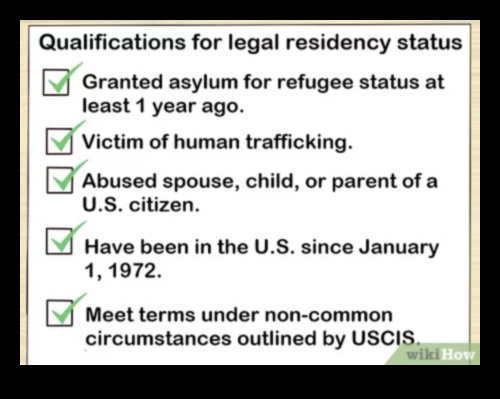How to Become a Legal Resident in 6 Steps


How to Become a Legal Resident
II. Requirements for Becoming a Legal Resident
III. The Application Process
IV. Costs of Becoming a Legal Resident
V. Benefits of Becoming a Legal Resident
VI. Drawbacks of Becoming a Legal Resident
VII. The Timeline for Becoming a Legal Resident
VIII. Tips for Becoming a Legal Resident
IX. Frequently Asked Questions
X. Conclusion
| Topic | Answer |
|---|---|
| Illegal Immigration | Illegal immigration is the act of entering a country without permission from the government. |
| Legal Immigration | Legal immigration is the act of entering a country with permission from the government. |
| Visa | A visa is a document issued by a government that allows a foreign national to enter and stay in that country for a specific period of time. |
| Green Card | A green card is a document issued by the United States government that allows a foreign national to live and work permanently in the United States. |
| Citizenship | Citizenship is the status of being a citizen of a country. |
II. Requirements for Becoming a Legal Resident
In order to become a legal resident of the United States, you must meet the following requirements:
- You must be a lawful permanent resident (LPR) or have been granted asylum or refugee status.
- You must have been physically present in the United States for at least 30 days.
- You must have a valid Social Security number.
- You must have a job offer from a U.S. employer that is willing to sponsor your application for a green card.
- You must be able to speak, read, and write English at a basic level.
- You must have a clean criminal record.

III. The Application Process
The application process for becoming a legal resident can be complex and time-consuming. It is important to be aware of all of the requirements and to gather all of the necessary documents before you begin the process. The application process typically includes the following steps:
- Submitting an application form
- Providing proof of your identity and legal status
- Paying the application fee
- Attending an interview with a U.S. Citizenship and Immigration Services (USCIS) officer
- Passing a medical exam
- Submitting your fingerprints
The length of time it takes to process your application will vary depending on the type of visa you are applying for and your individual circumstances. However, it is important to be prepared for the process to take several months or even years.
If you are approved for a green card, you will be required to live in the United States for a certain number of years before you can apply for citizenship. The length of time you must live in the United States before you can apply for citizenship varies depending on the type of visa you are holding.
IV. Costs of Becoming a Legal Resident
The costs of becoming a legal resident vary depending on the immigration category you are applying under. However, some of the common costs include:
- Immigration filing fees
- Medical examinations
- Apostilles and translations
- Legal fees
The total cost of becoming a legal resident can range from a few thousand dollars to tens of thousands of dollars. It is important to budget for these costs when you are considering applying for legal residency.
For more information on the costs of becoming a legal resident, please visit the U.S. Citizenship and Immigration Services website.

V. Benefits of Becoming a Legal Resident
There are many benefits to becoming a legal resident of the United States, including:
The ability to work legally. Legal residents can obtain a work permit, which allows them to work in the United States without restriction. This can lead to increased earnings and job opportunities.
The ability to travel freely. Legal residents can travel in and out of the United States without restriction. This can make it easier to visit family and friends in other countries, or to take advantage of travel opportunities.
The ability to access government benefits. Legal residents are eligible for a variety of government benefits, such as Social Security, Medicare, and food stamps. This can help to improve their financial security and well-being.
The ability to sponsor family members for immigration. Legal residents can petition for their spouses, children, and parents to immigrate to the United States. This can help to reunite families and provide them with the opportunity to live together in the United States.
The ability to apply for citizenship. After five years of continuous residency, legal residents can apply for citizenship. This can give them the right to vote, run for office, and serve on juries.
These are just a few of the benefits of becoming a legal resident of the United States. If you are an undocumented immigrant, you may want to consider applying for legal status in order to enjoy these benefits.

VI. Drawbacks of Becoming a Legal Resident
There are a number of drawbacks to becoming a legal resident of the United States. These include:
Increased cost of living. Legal residents are required to pay taxes, which can increase the cost of living.
Loss of certain rights. Legal residents are not eligible for all the same rights and benefits as citizens, such as the right to vote.
Increased scrutiny. Legal residents are subject to more scrutiny by law enforcement and immigration authorities.
Difficulty traveling. Legal residents may have difficulty traveling outside of the United States, as they may need to obtain a visa for each country they visit.
Risk of deportation. Legal residents can still be deported if they violate the terms of their residency status.

VII. The Timeline for Becoming a Legal Resident
The timeline for becoming a legal resident can vary depending on the individual’s circumstances. However, the following is a general overview of the process:
- Initial application: The first step is to file an application for a green card. This can be done through either the family-based or employment-based immigration system.
- Processing time: The processing time for a green card can vary depending on the type of application and the current backlogs. For example, family-based green cards typically take longer to process than employment-based green cards.
- Interview: Once the green card application is approved, the applicant will be scheduled for an interview at a U.S. consulate or embassy.
- Medical exam: The applicant will also need to undergo a medical exam.
- Green card issuance: If the applicant is approved for a green card, they will be issued a document called a “green card.” This card will allow them to live and work in the United States permanently.
The entire process of becoming a legal resident can take anywhere from a few months to a few years. However, it is important to remember that the timeline is just a general guideline and may vary depending on the individual’s circumstances.
Tips for Becoming a Legal Resident
Here are some tips for becoming a legal resident of the United States:
- Do your research. There are many different ways to become a legal resident, and the requirements vary depending on your circumstances. Make sure you understand the different options available to you and the steps involved in each one.
- Get started early. The process of becoming a legal resident can take time, so it’s important to get started early. The sooner you start, the sooner you’ll be able to achieve your goal.
- Be prepared to provide documentation. In order to apply for a green card, you’ll need to provide a variety of documents, including proof of your identity, your legal status in the United States, and your financial ability to support yourself.
- Meet the requirements. Each category of green card has its own set of requirements. Make sure you meet all of the requirements for the category you’re applying for.
- Be patient. The process of becoming a legal resident can be long and frustrating. It’s important to be patient and persistent.
IX. Frequently Asked Questions
Here are some frequently asked questions about how to become a legal resident in the United States:
What are the requirements for becoming a legal resident?
What is the application process for becoming a legal resident?
How much does it cost to become a legal resident?
What are the benefits of becoming a legal resident?
What are the drawbacks of becoming a legal resident?
What is the timeline for becoming a legal resident?
What are some tips for becoming a legal resident?
Frequently Asked Questions
Q: What is the difference between a legal resident and a citizen?
A: A legal resident is someone who has been granted the right to live and work in the United States permanently, but is not a citizen. A citizen is someone who has been granted the full rights and privileges of being a U.S. citizen, including the right to vote and hold public office.
Q: What are the requirements for becoming a legal resident?
A: The requirements for becoming a legal resident vary depending on your immigration status. For example, if you are a foreign national who is married to a U.S. citizen, you may be eligible to apply for a green card through marriage. If you are a foreign national who has been working in the United States for a certain number of years, you may be eligible to apply for a green card through employment.
Q: What is the application process for becoming a legal resident?
The application process for becoming a legal resident can be complex and time-consuming. It typically involves submitting a variety of documents, including a visa application form, a passport, and proof of financial support. You may also need to attend an interview with a U.S. immigration officer.




